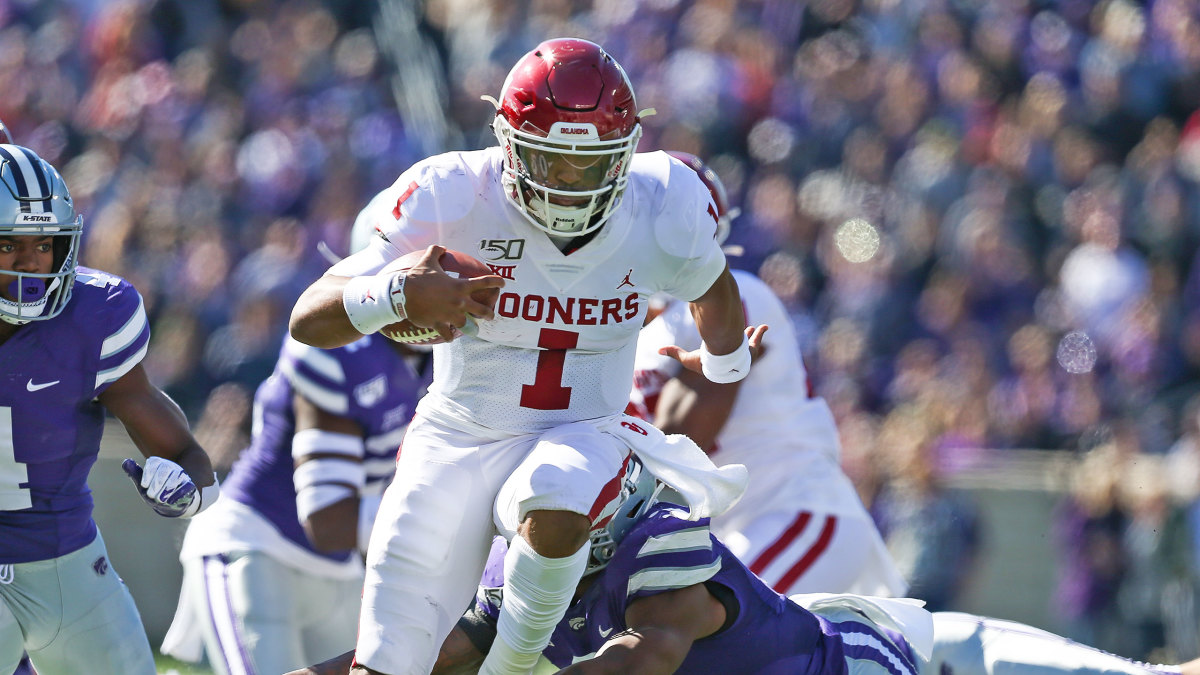Oklahoma's Upset Loss Opens Door for Fascinating Potential Playoff Scenarios


Last week, Oklahoma’s Sooner Schooner crashed onto the field during OU’s win over West Virginia, spilling contents and people across the turf in a somewhat scary incident that, luckily, resulted in no serious injuries. Maybe that was an omen. The Sooners crashed themselves Saturday in a most stunning way, losing 48–41 to a Kansas State team that won five games last year and has a first-year coach.
For a third week in a row, a top-six, previously unbeaten team fell. The playoff race has dramatically changed again. The contenders are dropping like flies. It started three weeks ago with then-No. 3 Georgia’s loss at home to South Carolina, then we had Illinois—Illinois!—take down then-No. 6 Wisconsin, followed Saturday by the Wildcats shocking the Sooners in a game they led at one point by 25 points. The madness has begun, and it’s not even Halloween yet.
Among serious contenders, the playoff race has gone from about eight teams to four very quickly. Those four: Alabama, LSU, Ohio State and Clemson. There are plenty other legitimate contenders, of course. Penn State entered its game Saturday against Michigan State undefeated. Baylor and Minnesota hadn’t lost games either. There are a host of one-loss teams with decent résumés, too: Notre Dame, Georgia, Oregon, Utah, Florida and of course the recently defeated Oklahoma. But four teams seem to have distanced themselves by their performances and résumé: the Tide, Tigers, Buckeyes and other Tigers. The first two of those teams play one another Nov. 9 in Tuscaloosa. The Buckeyes will be heavily favored the rest of the season, including at home against Penn State on Nov. 23. Clemson will be heavily favored the rest of the way as well.
That leaves us with two spots to fill. As crazy as it might sound, LSU and Alabama, even though they play each other, might have the best shots at those two spots—at least, assuming they win their own Week 9 games. Heck, the loser of Tigers-Tide on Nov. 9 may actually be in better position to make the playoff than the winner. Yes, we know, college football is weird, but think about it. The loser will have three more regular-season games. The winner, potentially a participant in the SEC championship game, could have to play four more games. We all remember what happened in 2017, when one-loss Alabama, not representing the SEC in the title game, landed the No. 4 seed in the playoff, beat Clemson in the semifinal and won the championship over three-seed Georgia in the title bout. Granted, that was a weird year. That season, there were no undefeated Power 5 programs after championship Saturday.
Oklahoma’s loss not only allows the LSU-Alabama loser back into the party, but it also is a gift to those out west. Oregon, its only loss on a neutral field to Auburn, and Utah, its only loss on the road at USC, are heading toward a potential showdown in the Pac-12 title game. The Sooners aren’t completely out of it, either (remember, they made the playoff with a loss in both 2015 and 2017), but they probably no longer control their own destiny. They need some help after the debacle in Manhattan, Kansas. It was the first true road loss for Oklahoma in 1,841 days, dating back to a 2014 defeat at TCU.
The Sooners’ defense was gouged. They allowed 426 yards, 213 on the ground, and the Wildcats hogged the ball for more than 38 of the 60 minutes. It’s a good recipe to beat OU. If QB Jalen Hurts isn’t on the field, he can’t score. Hurts and Co. stormed back to make it respectable, but the committee will surely see this as a dreaded bad loss, and that opens the door for so many possibilities. Does a one-loss Big 12 champion Oklahoma team get the nod over an 11-1 LSU-Alabama loser? Does a one-loss Pac-12 title winner leap the Sooners? How would the committee handle a one-loss Notre Dame? What if Penn State’s only loss is at Ohio State, potentially the CFP’s top seed? If Georgia or Florida upsets the SEC West champion in the title game, the SEC could have three one-loss teams. What then?
Madness is what we love in college football, and it looks like we’re getting it.
